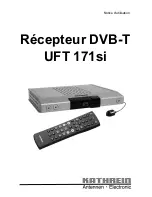
05-2806A01, Rev. L
MDS iNET Series Reference Manual
33
CAUTION:
Changes to any of the following parameters while communicating over the network (LAN or
over-the-air) may cause a loss of communication with the unit being configured. Communication
will need to be re-established using the new IP address.
•
IP Address Mode
—Defines the source of the IP address of this device. The IP address must be con-
figured manually when set to Static. A DHCP server must be available for the radio to obtain a valid
IP address when set to Dynamic. Enabling this option forces the transceiver (AP or Remote) to obtain
an IP address from any DHCP server available on the LAN. Dynamic Mode is also known as DHCP
Client mode. Only static IP addressing mode is available when VLAN Status is enabled [
Static;
Static, Dynamic
].
•
Static IP Address
—The IPv4 local IP address. It need not be defined if DHCP Client mode is enabled.
[
192.168.1.1
]
•
Static IP Netmask
—The IPv4 local subnet mask. This value is used when the radio attempts to send
a locally initiated message, either from the terminal server, or management process. You don’t have
to define it if DHCP Client mode is enabled. [
255.255.0.0
]
•
Static IP Gateway
—The IPv4 address of the default gateway device, typically a router. [
0.0.0.0
]
The lower three lines of the screen show the actual addressing at the transceiver, whether it was obtained
from static configuration or from a DHCP server.
NOTE:
Any change made to the above parameters results in the
Commit Changes
option appearing on
screen. This allows all IP settings to be changed at the same time.
2.4.3 Ethernet Port Configuration Menu
The transceiver allows for special control of the Ethernet interface, to allow traffic awareness and avail-
ability of the backhaul network for redundancy.
NOTE:
The Ethernet port in iNET and iNET-II radios support 10BaseT connections only. This should not
present a problem because most hubs/switches auto-switch between 10BaseT and 100BaseT
connections. Confirm that your hub/switch is capable of auto-switching data rates.
To prevent Ethernet traffic from degrading performance, place the transceiver in a segment, or
behind routers.
Figure 2-23. Ethernet Port Configuration Menu
(AP menu shown; Remote omits items D through G)
Summary of Contents for MDS iNET Series
Page 12: ...x MDS iNET Series Reference Manual 05 2806A01 Rev L...
Page 159: ...05 2806A01 Rev L MDS iNET Series Reference Manual 147 Figure A 22 EDS Wizard Completion Screen...
Page 165: ...05 2806A01 Rev L MDS iNET Series Reference Manual 153 NOTES...
Page 166: ...154 MDS iNET Series Reference Manual 05 2806A01 Rev L NOTES...
















































